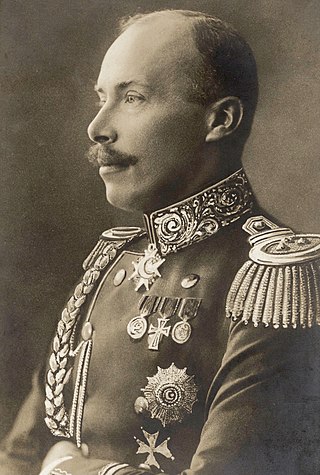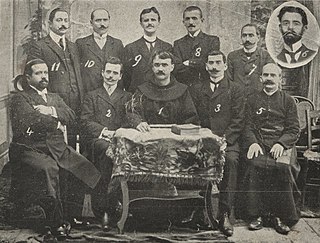
Wilhelm, Prince of Albania was sovereign of the Principality of Albania from 7 March to 3 September 1914. His reign officially came to an end on 31 January 1925, when the country was declared an Albanian Republic.

Essad Toptani was an Albanian politician who served as the third prime minister of Albania from 1914 to 1916. He previously established the Republic of Central Albania based in Durrës. An Ottoman army officer, he served as the Albanian deputy in the Ottoman Parliament and later cooperated with the Balkan League after the Balkan Wars.

Krujë is a town and a municipality in north central Albania. Located between Mount Krujë and the Ishëm River, the city is 20 km north of the capital of Albania, Tirana.

Sadije Toptani was queen mother of Albania from September 1928 until her death. She was the mother of Zog I of Albania.

Fejzi Bey Alizoti was an Ottoman and later Albanian politician who served as the Chairman of the Central Administration of Albania from January 1916 to October 1918. He never held the title "prime minister" as is commonly misconceived.

The Congress of Manastir was an academic conference held in the city of Manastir from November 14 to 22, 1908, with the goal of standardizing the Albanian alphabet. November 22 is now a commemorative day in Albania, Kosovo and North Macedonia, as well as among the Albanian diaspora, known as Alphabet Day. Prior to the Congress, the Albanian language was represented by a combination of six or more distinct alphabets, plus a number of sub-variants.

Abaz Kupi or Abas Kupi. He was also known as Bazi i Canës. He was an Albanian military officer.

The Republic of Central Albania was a short-lived unrecognised state established on 16 October 1913, with its administrative centre in Durrës, today in Albania.

The Peasant Revolt, also known as the Muslim uprising and in Albania as the Central Albania Uprising, was an uprising of peasants from central Albania, mostly Muslims against the regime of Wilhelm, Prince of Albania during 1914. It was one of the reasons for the prince's withdrawal from the country which marked the fall of the Principality of Albania. The uprising was led by Muslim leaders Haxhi Qamili, Arif Hiqmeti, Musa Qazimi and Mustafa Ndroqi. Along with a demand of total amnesty, the rebels required the return of Albania to the suzerainty of the Sultan of the Ottoman Empire.

The International Gendarmerie was the first law enforcement agency of the Principality of Albania. It was established by the decision of the ambassadors of the six Great Powers that participated in the London Peace Conference. This decision was made on the basis of the London Treaty signed on 30 May 1913. Since most of the members were from the Netherlands, this force was also known as the Dutch Military Mission.

The Treaty of Serbian–Albanian Alliance, also known as the Treaty of Niš,
Mustafa Ndroqi(born Mustafa Mancaku) was an Albanian landowner who played an important role in the Revolts of 1914–15.

Independent Albania was a parliamentary state declared in Vlorë on 28 November 1912 during the First Balkan War. Its assembly was constituted on the same day while its government and senate were established on 5 December 1912.

Aziz Pasha Vrioni (1859–1920) was an Ottoman-Albanian politician of the early 20th century. He was a member of the Ottoman Parliament representing Berat, and Albanian Minister of Finance and Minister of Agriculture and of Mines.

Haxhi Qamili, born Qamil Zyber Xhameta, was the leader of the 1914–15 revolt in Albania. He was popularly known by his religious name Haxhi Qamili, though he was also known as Baba Qamili.
Musa Qazimi was an Albanian politician and rebel. A Turcophile mufti, he was first the mayor (1904-1908), then the mufti (1908-1913), and finally the prefect of Tirana (1913-1914). In the turbulent period after the Albanian declaration of independence from the Ottoman Empire, he was first a supporter of the Young Turks, then of Essad Pasha. After he broke with Essad Pasha, he defected and became a leader in the sectarian, reactionary and clerically tinged pro-Ottoman revolt against the new Albanian state's authorities. While the official head of the movement was Haxhi Qamili and the head of its armed forces was Mustafa Ndroqi, Qazimi has been considered to be the ideological inspiration of the movement., and the "real leader" of the uprising. After the revolt was shattered by a makeshift alliance consisting of Mirdita Catholics, local resistance, Kosovar Albanians led by Isa Boletini and some foreign volunteers mainly from Romania, he was found guilty of orchestrating the slaughter that occurred during his revolt against supporters of the Albanian national movement as well as Bektashis and Christians, and he was executed on July 7, 1915.

Faik Bey Konica was an important figure in Albanian language and culture in the early decades of the twentieth century. As the Albanian minister to Washington, D.C., his literary review Albania became the focal publication of Albanian writers living abroad. Faik Konica wrote little in the way of literature, but he was an influential stylist, critic, publicist and political figure in Albanian culture.
The Taksim meeting alternatively known as the Taksim Plot and less commonly as the Taksim Assembly was a secret meeting held in January 1912 by Albanian nationalist deputies of the Ottoman parliament and other prominent Albanian political figures. The event gets its name from Taksim Square because of the location of the house where it was held. The meeting was organized on the initiative of Hasan Prishtina and Ismail Qemali, Albanian politicians, who invited most of the MPs of Albanian origin and aimed at launching an armed general uprising in Albanian territories against the central government headed by the Committee of Union and Progress (CUP). The meeting followed two other Albanian uprisings of 1910 in the Vilayet of Kosovo and 1911 in the mountains of upper Shkodra. The Taksim meeting resulted in an uprising the same year, with armed uprisings in Shkodër, Lezhë, Mirditë, Krujë and other Albanian provinces, which exceeded the organizers' expectations. The biggest uprising was in Kosovo, where the rebels were more organized and managed to take over important cities like Prizren, Peja, Gjakova, Mitrovica and others.

Gani bej Toptani was an Ottoman Albanian officer and adjutant of Sultan Abdülhamid II. After a short military career in Janina, he was exiled to Harpoot, but was soon called to Constantinople to serve under Sultan Abdülhamid II as his personal bodyguard. He was the elder brother of Essad Pasha Toptani, who would later ascend as a political and military figure, both in the Ottoman Empire and later in independent Albania. Gani Toptani was killed in 1898 in the Pera district of Constantinople after a conflict that would cause political tension. Three years later, his brother Essad would also carry out an assassination attempt as revenge against Cavid Bey, a member of the Imperial Council and also the son of Grand vizier Halil Rifat Pasha, who is thought to have ordered Gani's assassination.

The Sanjak of Durrës was one of the sanjaks of the Ottoman Empire. It was named for its capital Durrës and was also known as the Sanjak of Durazzo from its capital's Italian name. The sanjak was composed of the kazas of Durrës, Tirana, Shijak, Kavajë, and Krujë. The Sanjak of Durrës formed the southern half of the Vilayet of Scutari. The northern half was the Sanjak of Scutari. Durrës Sanjak also bordered the sanjaks of Manastir and Dibra to its northeast and the sanjak of Elbasan to the east and south. Its western border was the Adriatic Sea. Its terrain is generally flat and plain. Only the eastern parts of the kazas of Tirana and Kavajë were mountainous.


















